Ancient Greek Government › Viking Raids in Britain › Mesrop Mashtots » Origins and History
Articles and Definitions › Contents
- Ancient Greek Government › Origins
- Viking Raids in Britain › Origins
- Mesrop Mashtots › Origins
Ancient civilizations › Historical places, and their characters
Ancient Greek Government › Origins
Definition and Origins

The government systems of ancient Greece were varied as the Greeks searched for the answers to such fundamental questions as who should rule and how? Should sovereignty ( kyrion ) lie in the rule of law ( nomoi ), the constitution ( politea ), officials, or the citizens? Not settling on a definitive answer to these questions, government in the ancient Greek world, therefore, took extraordinarily diverse forms and, across different city -states and over many centuries, political power could rest in the hands of a single individual, an elite or in every male citizen: democracy - widely regarded as the Greeks' greatest contribution to civilization.
The four most common systems of Greek government were:
- Democracy - rule by the people (male citizens).
- Monarchy - rule by an individual who had inherited his role.
- Oligarchy - rule by a select group of individuals.
- Tyranny - rule by an individual who had seized power by unconstitutional means.
Our knowledge of the political systems in the ancient Greek world comes from a wide range of sources. Whilst for Athens, it is possible to piece together a more complete history, we have only an incomplete picture of the systems in most city-states and many details of how the political apparatus actually functioned are missing. Surviving, though, are over 150 political speeches and 20,000 inscriptions which include 500 decrees and 10 laws. There are also two specifically political texts with the same title, The Constitution of the Athenians, one written by Aristotle or one of his pupils and the other attributed (by some) to Xenophon. Other sources which discuss politics and government include Aristotle's Politics and the historical works of Herodotus, Thucydides, and Xenophon. In addition, politics is often lampooned in the comedies of Aristophanes.
DEMOCRACY
Athens' constitution is called a democracy because it respects the interests not of the minority but of the whole people. When it is a question of settling private disputes, everyone is equal before the law; when it is a question of putting one person before another in positions of public responsibility, what counts is not membership of a particular class, but the actual ability which the man possesses. ( Pericles, 431 BCE)
ANY MALE CITIZEN 18 YEARS OR OVER COULD SPEAK (AT LEAST IN THEORY) & VOTE IN THE ASSEMBLY OF ATHENS.
The word democracy derives from the Greek dēmos which referred to the entire citizen body and although it is Athens which has become associated with the birth of democracy ( demokratia ) from around 460 BCE, other Greek states did establish a similar political system, notably, Argos, (briefly) Syracuse, Rhodes, and Erythrai. Athens is, however, the state we know most about. The assembly of Athens met at least once a month, perhaps two or three times, on the Pnyx hill in a dedicated space which could accommodate 6000 citizens. Any male citizen 18 years or over could speak (at least in theory) and vote in the assembly, usually with a simple show of hands. Attendance was even paid for in certain periods which was a measure to encourage citizens who lived far away and couldn't afford the time-off to attend.
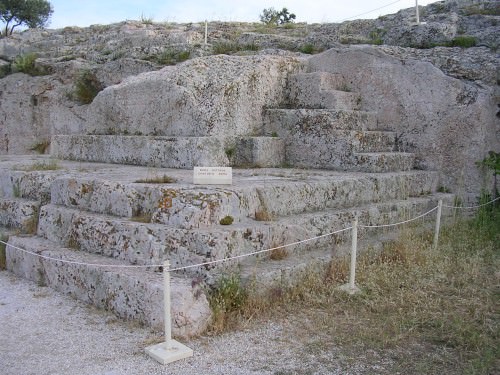
Speaker's Platform, Athens Assembly, Pynx, Athens
Citizens probably accounted for 10-20% of the polis population, and of these it has been estimated that only 3,000 or so people actively participated in politics. Of this group, perhaps as few as 100 citizens - the wealthiest, most influential, and the best speakers - dominated the political arena both in front of the assembly and behind the scenes in private conspiratorial political meetings ( xynomosiai ) and groups ( hetaireiai ). Critics of democracy, such as Thucydides and Aristophanes, also pointed out that the dēmos could be too easily swayed by a good orator or popular leaders (the demagogues) and get carried away with their emotions. Perhaps the most famous bad decision from the Athenian democracy was the death sentence given to the philosopher Socrates in 399 BCE.
Issues discussed in the assembly ranged from deciding magistracies to organising and maintaining food supplies to debating military matters. There was in Athens (and also Elis, Tegea, and Thasos) a smaller body, the boulē, which decided or prioritised the topics which were discussed in the assembly. In addition, in times of crisis and war, this body could also take decisions without the assembly meeting. The boulē or council of 500 citizens was chosen by lot and had a limited term of office, which acted as a kind of executive committee of the assembly. The decrees of the Assembly could also be challenged by the law courts. Similar in function to the boulē was the council of elders (selected men over 60), the gerousia, of Sparta, which also had the two Spartan kings as members and had certain legal powers. Similar bodies of elders existed in Corinthand Stymphalos. In Athens, the Areopagus was a similar such council, where elders were made members for life.

Socrates
In other Greek states then, there were also democratic assemblies, sometimes, though, with a minimum property stipulation for attendees (as in the Boiotian federation 447-386 BCE). Some city-states also mixed democratic assemblies with a monarchy (for example, Macedonia and Molossia).
THE KINGS OF SPARTA WERE KEPT IN CHECK BY EPHORS (EPHOROI) WHO WERE THEMSELVES ELECTED BY THE ASSEMBLY.
MONARCHY
In the Greek world monarchies were rare and were often only distinguishable from a tyranny when the hereditary ruler was more benevolent and ruled in the genuine interest of his people. The most famous monarchies were those in the states of Macedonia and Epeiros, where the ruler shared power with an assembly, limited though these were in practice. Although Sparta also possessed a citizen assembly, it is most famous for its system of two kings. Not absolute monarchs, they did, however, hold great power when they led the Spartan army in times of war. During peacetime the kings were kept in check by ephors ( ephoroi ) who were themselves elected by the assembly. Clearly, a degree of political consensus was necessary for this overlapping apparatus to function. The kings were also members of the gerousia and were admitted from a young age, so that they must have had a significant advantage over the other members who couldn't join until they were 60. Spartan kings could, however, be put on trial and even exiled.
TYRANNY
Tyrants were sole rulers of a state who had taken power in an unconstitutional manner, often murdering their predecessor.However, Greek tyrants were not necessarily evil rulers (as the word signifies today); they simply looked after their own interests. Syracuse in Sicily had a run of famous tyrants, for example, Dionysios from 405 BCE and his son Dionysios II, who took over in 367 BCE. Others include Pesisistratos in Athens (from c. 560 BCE) - a typical benevolent tyrant who actually paved the way for democracy, Pheidon in Argos (c. 660 BCE), Lykophron in Thessaly, the Kypselidai, which included Periander, in Corinth (c. 657-585 BCE), and Polykrates in Samos (530-522 BCE). For Athenians, tyranny became the exact opposite of democracy, a position that allowed the citizens of Athens to feel a certain superiority. This feeling was especially evidenced in the demonizing of the Persian kings Darius and Xerxes, the tyrants par excellence.

Periander
OLIGARCHY
An oligarchy is a system of political power controlled by a select group of individuals, sometimes small in number but it could also include large groups. For the Greeks (or more particularly the Athenians) any system which excluded power from the whole citizen-body and was not a tyranny or monarchy was described as an oligarchy. Oligarchies were perhaps the most common form of city-state government and they often occurred when democracy went wrong. Unfortunately, information concerning oligarchies in the Greek world is sparse. We know that in 411 BCE in Athens, 'the oligarchy of the 400' took power out of the hands of the Assembly and were themselves superseded by a more moderate oligarchy of 5000. In 404 BCE, following the defeat of the Athenian military forces in Sicily, there was an oligarchy of ' the Thirty Tyrants ' in Athens which was a particularly brutal regime, noted for its summary executions. Megara and Thebes were other states which had an oligarchic system.
THERE WAS A CERTAIN EXPECTATION THAT THE HONOURABLE CITIZEN WOULD PLAY HIS ACTIVE PART IN CIVIC LIFE.
PUBLIC OFFICIALS
In Athens the law was devised and enforced by magistrates ( archai ). All citizens were eligible for the position, and indeed there may well have been a certain expectation that the honourable citizen would play his active part in civic life. For the Greeks, the state was not seen as an interfering entity which sought to limit one's freedom but as an apparatus through which the individual could fully express his membership of the community. The regular turnover of archai, due to limited terms of office and the prohibition of re-election, meant abuse of power was kept in check and the rulers would, in turn, become the ruled. Various boards of officials also existed to make administrative decisions; members of these were usually taken from each of the ten traditional tribes. Many civic positions were short-term and chosen by lot to ensure bribery was kept to a minimum. Importantly, positions of power often required not only free time but also financial layout to fund municipal projects such as shipbuilding and festivals. Therefore, it was probably the case that public positions were in reality dominated by the wealthier citizens.
In Sparta, the most important state officials were the five ephors. These were probably elected by the assembly of Sparta and they held office for only one year. However, during that time they had power over most areas of civic life and they could appoint and check on all the other public officials.
Military commanders also held public office in some city-states. In Athens, the board of ten elected generals, known as the strategoi, could influence the agenda of the assembly and so prioritise their own causes. They were subject to votes of confidence by the Assembly but this didn't stop Pericles, for example, holding office as strategos for 15 consecutive years.
Viking Raids in Britain › Origins
Ancient Civilizations
The Viking raids and subsequent settlements define the period known as the Viking Age in Britain which had profound consequences on the development of the culture and language. The raids started in June of 793 CE when three ships docked at the shore by the abbey of Lindisfarne. The abbey's reeve, Beaduheard, believed he recognized them as those of Norse traders and, thinking they had lost their way, went out to direct them up the coast to the estate he thought they had been aiming for. Upon approaching the ships, however, he was instantly killed by the sailors who then sacked the abbey and murdered everyone they found inside or on the grounds; this was only the beginning.

Viking Raids in Britain
The raids continued in 794 CE when Viking ships sacked the monastery of Jarrow in Northumbria, in 795 CE when they struck at the monastery of Iona in Scotland and, in the same year, attacked sites in Ireland. Raids and military incursions continued in Britain through c. 1066 CE, ending with the invasion by the great Norwegian king Harald Hardrada (1046-1066 CE), known as “the last of the Vikings ”, whose victories over the Anglo- Saxon king Harold Godwinson (1066 CE) contributed significantly to William the Conqueror's Norman victory over Harold at The Battle of Hastings later in the same year.
The Vikings were all from Scandinavia but the term did not designate a homogeneous group; rather, it referred to one who joined an expedition expressly for the purpose of raiding others for personal gain. The Old Norse phrase fara i viking (meaning “to go on expedition”) is understood as meaning something closer to piracy and robbery than legitimate trade.
Although the Vikings may have begun as little more than pirates in Britain, they would eventually arrive as great armies under skilled military leaders, establish communities, and assimilate with the population. The Viking Age is known for legendary Norse leaders such as:
- Halfdan Ragnarsson (also known as Halfdane, c. 865-877 CE)
- Ivar the Boneless (c. 870 CE), Halfdan's brother
- Guthrum (c. 890 CE)
- Harold Bluetooth (c. 985 CE)
- Sven Forkbeard (986-1014 CE), Harold's son
- Cnut the Great (1016-1035 CE)
- Harald Hardrada (1046-1066 CE)
Other notable Norse explorers of the time were Eric the Red (died 1003 CE) and Leif Erikson (died c. 1020 CE) who explored and settled Greenland and North America.
In Britain, this was also the period of famous rulers such as Alfred the Great (871-899 CE), Edward the Elder (899-924 CE), and Queen Aethelflaed of the Mercians (911-918 CE) among others while, in France, it was the time of Charlemagne (800-814 CE) whose efforts at Christianizing the “heathen” Norse have been recognized as contributing to the ferocity of the Viking raids in Britain and elsewhere.
SPONSORSHIP MESSAGE
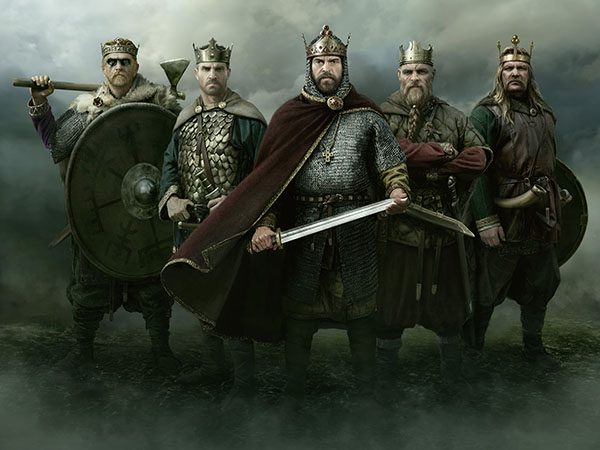
REASONS FOR THE RAIDS
The primary reason given by medieval historians for the Viking raids was God's displeasure at the people's sin and selfishness. The scribe Alcuin (died c. 804 CE) epitomizes this view in a letter from 793 CE to Aethelred, King of Northumbria in which he complains about the moral decline of the country and attributes the Viking raid at Lindisfarne to God's wrath:
What may I say about avarice, robbery, violent judgments? – when it is clearer than day how much these crimes have increased everywhere and a despoiled people testifies to it. Whoever reads the Holy Scriptures and ponders ancient histories and considers the fortune of the world will find that for sins of this kind kings lost kingdoms and peoples their country; and while the strong unjustly seized the goods of others, they justly lost their own. (Somerville & McDonald, 186).
The Anglo-Saxon Chronicle likewise attributes the raid to a supernatural cause. The entry for the year 793 CE reads:
In this year, terrifying omens appeared over Northumbria and the people were wretchedly afraid. There were huge flashes of lightning and terrifying dragons were seen flying in the air. A great famine followed these signs and shortly after that, on the sixth day before the Ides of January, the miserable raiding of heathens destroyed God's church on the Isle of Lindisfarne through plundering and murder. (Somerville & McDonald, 184).
The scribe Dudo (died c. 1027 CE) attributed the raids to overpopulation in Scandinavia and the generally depraved state of the “barbarians” who were forced to find new areas to inhabit overseas:
Now these people burn with too much wanton lasciviousness and with singular depravity debauch and mate with as many women as they please; and so, by mingling together in illicit couplings, they generate innumerable children. When these have grown up, they clamor fiercely against their fathers and their grandfathers, or more frequently against each other, for shares of property; and, as they are over-many, and the land they inhabit is not large enough for them to live in, there is a very old custom by which a multitude of youths is selected by lot and expelled into the realms of other nations, to win kingdoms for themselves by fighting. (Somerville & McDonald, 182-183)
This last suggestion gained credence with later writers and became the standard explanation for the Viking raids, but there is no more evidence for it in historical events than the wrath-of-god explanation. The clearest cause for the Viking raids was simply the acquisition of wealth. Britain, especially, was well known for its lucrative trade centers, and the Scandinavians were aware of this through their own commerce with the region.
The first sites struck were all religious institutions but this seems to have had more to do with convenience than any other consideration; the abbeys and priories which first fell to the Vikings were located near the coast. Although the Anglo-Saxon Chronicle gives a January date for the raid on Lindisfarne, other sources make clear it was in June, and this would make sense as the seas would have been calmer and provided greater ease in travel. It would have been pointless to go further inland upon reaching Britain when there were such easy targets within range of the sea, and the Lindisfarne Priory was an exceptionally wealthy one.
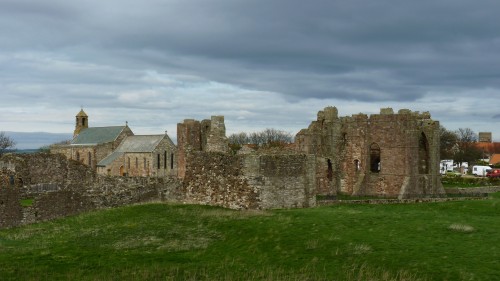
Lindisfarne
Lindisfarne had been founded in c. 635 CE and became the most important pilgrimage site in the region following reports of miracles associated with the bishop St. Cuthbert (c. 634-670 CE) who presided there. St. Cuthbert was credited with all manner of miraculous events after his death when the monks, who had opened his coffin, found his body in a perfect state of preservation and elevated him to sainthood.
Following this event, people regularly came to Lindisfarne to pray to the saint, receive answers to these prayers, and further invoke his protection for themselves and their communities; in return, they gave the priory rich gifts – as much as they could afford – in thanks for continued miracles and protection. The Viking raid on this particular religious community, then, was especially devastating because St. Cuthbert had obviously failed to protect his own people in the priory and so there seemed little chance he would do better for others.
In the same way that the Huns had struck unexpectedly and brutally against the eastern cities of the Roman Empire in the 5th century CE, the Vikings now did in Britain. As with the Huns, there was no way to prepare for an attack, no understanding of where the adversary came from, and no discernible motive other than slaughter and robbery. The savagery of the unwarranted attacks, especially on religious institutions, encouraged the belief that the Vikings had been sent by God to punish the people for their sins; in much the same way Attila the Hun was designated the “scourge of God” by the prelates of his time. This new scourge, it was thought, was sent to destroy the shepherds of the Christian flock in Britain which would then lead to the destruction of everything else.
RELIGIOUS INFLUENCE ON RAIDS
It does not seem likely that the Vikings were targeting religious communities for any reason other than convenience, however.Far from targeting Lindisfarne for its religious association, the Vikings would have chosen it for its riches or, as scholar Janet T. Nelson observes, “what lured Vikings was movable wealth” (Sawyer, 36). The rich gifts given to Lindisfarne in thanks for answered prayers were, naturally, unprotected as the monks had no weapons nor any need for them. Similar religious communities followed this same paradigm and so made tempting targets for Viking raiders.
FAR FROM TARGETING LINDISFARNE FOR ITS RELIGIOUS ASSOCIATION, THE VIKINGS WOULD HAVE CHOSEN IT FOR ITS RICHES.
At the same time, however, religion did play a part in these raids, and this aspect is intimately tied in with trade and migration.In c. 2300 BCE Germanic-speaking peoples migrated to Scandinavia bringing with them their religious beliefs in fierce gods who rewarded brave heroes in battle. This period is known as the beginning of the Bronze Age (c. 2300 - c. 1200 BCE) in which people began manufacturing tools and weapons from bronze, an alloy of copper and tin. Increased need for these materials forced the Scandinavians to engage in long-distance trade with Europe and the Mediterranean which brought them into close contact with these other cultures.
In time, a number of Scandinavian traders established permanent communities in Europe and became Christianized while their families and neighbors back home continued to hold to their ancestral belief in the Norse gods. Professor Kenneth Harl notes that by 625 CE:
The West Germanic kinsmen of the Scandinavians had converted to Christianity and had begun to forget their own stories. Between 650 and 700 CE, new Christian cultures emerged in England, in the Frankish world, and in Frisia, which led to a parting of the ways between the Scandinavian heartland and the new states in the former Roman Empire. (25)
While these Scandinavian communities developed as Christians, the belief in the Norse gods back home did likewise. By the time of the 2nd-3rd centuries CE, the Norse god Odin had been elevated to a position of supremacy in the pantheon of Scandinavian religion, and Odin would become “the quintessential god of the Viking Age” (Harl, 15). Odin was the god of war, battle, military victory but also presided over thought, reason, poetry, song, and logic.
Those who followed him devoutly would come to be known as “berserkers” who fought fiercely in battle without any apparent fear of death. They did so because of their recognition of the gifts Odin had given them in life and their belief in the rewards which awaited them after death. According to Norse mythology, these heroes lived on in Odin's hall of Valhalla, feasting and drinking when they were not honing their martial skills, in preparation for the final cataclysmic battle of Ragnarok, the end of the known world. Odin wanted only the best warriors for this final engagement with the forces of chaos but also needed as many as he could muster. Proficiency in battle, therefore, became one of the defining and most highly valued skills for the Vikings, followers of Odin.

Odin on Sleipnir (Tjängvide image stone)
Since their kinsmen had neglected the old faith in favor of the new Christianity, there were no bonds of ancestry or honor to be considered when the Vikings encountered the people of Britain or elsewhere. It would have been considered dishonorable for a warrior to murder unarmed men – as happened at Lindisfarne – but only under certain conditions. One could not kill one's kinsmen without sound provocation or kill someone who had surrendered in battle (although there is ample evidence of this happening) but this consideration did not apply to those outside of the faith living in other countries.
The religion of the Norse, therefore, encouraged the raids in Britain which brought not only personal wealth and possible earthly fame but also immortality, should one die in battle, and the promise of a place in Odin's elite army for the battle at the end of the world. None of these raids would have possible, however, were it not for the skill the Scandinavians developed in woodworking and, especially, in building ships capable of making these voyages.
SHIPBUILDING
Rock carvings from Scandinavia dated to c. 4000-2300 BCE indicate that the people already knew how to build boats, driven by paddles, to navigate their coasts. Shipbuilding developed past this stage of essentially small ferry boats only around c. 300-200 BCE and would not develop further until interactions with Roman traders – as well as Celtic and Germanic merchants using Roman technology – c. 200-400 CE.
Professor Harl notes that the “first major ship we have is the Hjortspring ship from Als, an island off Denmark, dating from about 300-200 BCE” (42). This ship, however, follows the rudimentary design of the past and is powered by paddles. The first ship able to navigate the sea is known as the Nydam ship, also from Denmark, c. 350-400 CE.

Gokstad Viking Ship
Harl notes that “the most important innovation of the Romans was the sail” (43). It would be the sail which enabled the Vikings to travel the seas as they did and raid as they pleased. The other important aspect was the keel which was developed in the early 8th century CE as well as the keelson, a thick base which could support a large mast and sail. Harl describes one of these later ships:
The Gokstad burial ship (c. 900-905 CE) is a warship; it is 75 feet [23 m] long and had a keel and keelson capable of carrying a mast close to 45 feet [14 m] in height. The sail might have been 750-825 square feet [70-77 square meters]. This ship is a brilliant piece of work in combining strength and flexibility. All such Viking Age ships were built to ride the water, rather than to fight the waves. (44)
In these ships, the Vikings made their voyages from the coasts of Scandinavia to the regions known today as Britain, Scotland, Ireland, France, Germany, Italy, and other areas of the Mediterranean.
ARMIES & SETTLEMENTS
The early raids and the rich plunder they generated encouraged more elaborate military expeditions. In 865 CE the Great Army under the leadership of Halfdane and Ivar the Boneless arrived in East Anglia in a massive fleet and marched across the land. In 867 CE the city of York fell, in 868 CE Mercia was subjugated, and by 871 CE Halfdane had defeated every force sent against him and was so powerful that Alfred the Great had no choice but to pay him an exorbitant amount to leave Wessex.
Alfred's payment did not mean the Vikings had to leave Britain, however, and Halfdane continued exercising his power after Ivar the Boneless had gone home. He put down rebellions in his territories and established Danish legal practices and customs so that, by 875 CE, he had created a Viking kingdom in Britain and partitioned lands in Yorkshire as rewards for his veterans.His policies were continued by the warlord Guthrum who ravaged Wessex until his defeat by Alfred the Great at the Battle of Eddington in 878 CE which resulted in the partitioning of Britain into the kingdom of Wessex under Alfred and the region of the Danelaw under Guthrum.
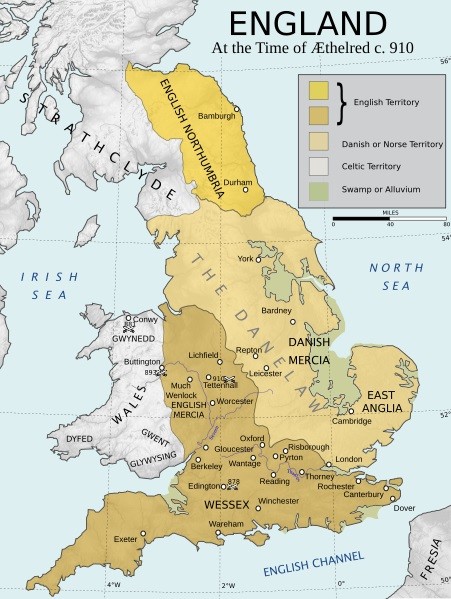
England Around 910 CE
While other Viking armies and explorers were busy expanding Scandinavian influences throughout the rest of the world, those who had settled in Britain went about domestic tasks as they would have once done back home. The Danelaw region operated under laws familiar to the Vikings, and they continued to observe their old religion. Back home in Denmark, however, the king Harold Bluetooth had converted the Danes to Christianity which his son, Sven Forkbeard, objected to. Possibly because of this religious difference – though clearly influenced by other factors as well – Sven deposed his father.
THE VIKING LEGACY
Sven invaded Britain, allegedly in response to a massacre of the Danes there, in 1013 CE. His son, Cnut, marched with him as a commander of part of the force. After Sven's death in 1015 CE, Cnut was proclaimed king of Denmark and united it with Britain under his rule. He would afterwards claim the thrones of both Norway and Sweden and bring those regions tightly under his control. Later historians refer to Cnut the Great as one of the most effective rulers of the Viking Age – or even any age – for his legal precepts and skill in both military and political spheres.
The last great Viking king, Harald Hardrada, rose from modest beginnings to serve in the prestigious Varangian Guard for the Byzantine Emperor and eventually become king of Norway. His invasion of Britain in 1066 CE did not result in winning the crown, as he had hoped, but significantly weakened the Anglo-Saxon forces under Harold Godwinson to the point where William the Conqueror's victory was almost assured at the Battle of Hastings.
The Norman Conquest of Britain in 1066 CE sent immigrants fleeing from their land to all parts of the western world, influenced the language and culture of the British Isles, and essentially set the course for the development of the west from that point forward. That conquest was made possible by the Viking invasion which preceded it, and the culture of the British Isles had developed from 793 - c. 1066 CE in response to Viking raids, assimilation, culture, and law. The world today, in fact, would be unrecognizable without the Vikings raids. Although they began as an easy means to wealth and personal glory, the Viking raids on Britain would come to define the culture not only of that region but of the western world.
Mesrop Mashtots › Origins
Definition and Origins

Mesrop Mashtots (360/370 - c. 440 CE) invented the Armenian alphabet in 405 CE. Besides greatly increasing levels of literacy in the country, the language permitted ordinary people to read the Bible for the first time, thus helping to further spread and entrench Christianity in Armenia, which was the original intention behind the script 's invention. For these achievements Mashtots (Mastoc) was made a saint of the Armenian Church.
EARLY LIFE
Mashtots came from a family of modest status living in Hatsekats, a provincial town in the Taron province of ancient Armenia.After an education focussed on Greek literature and an early career in the military, Mashtots served at the Armenian royal court before joining the Christian church and working as a missionary in the southeast of Armenia. It was then that the young evangelist realised how important it could be for his conversion rates if the people could read about the Gospel message in their own language, spoken Armenian not having, at that time, a written form. Christian texts were useless to common people as they were written in either Greek or Syriac, both of which only highly educated people could read. To do anything useful, though, Mashtots needed a powerful sponsor and state backing.
CREATING A NEW ALPHABET
Fortunately for Mashtots, the founder of the ruling Arsacid dynasty, Tiridates the Great (rc 298 - c. 330 CE), had converted to Christianity in 301 CE thanks to the efforts of Saint Gregory the Illuminator (c. 239 - c. 330 CE). Tiridates' successors were equally keen on spreading Christianity, especially as it reinforced the role of the monarch in the state as God's representative, and allowed the Arsacids to persecute and confiscate the property of any lingering adherents to the old pagan traditions. The reigning Arsacid monarch, then, Vrampshapuh (r. 392-415 CE), was willing to patronise Mashtots' project. Another supporter was the head bishop of the Armenian church, the Catholicos Sahak the Great (387-428 CE). Both men saw the value of enlightening the people and at the same time unifying them and creating a greater spirit of nationhood. Finally, the Christian faith in Armenia was far from secure and was continuously threatened by the religion of the neighbouring Persia.
MASHTOTS PUT HIS CREATION TO THE PURPOSE FOR WHICH IT WAS REALLY INVENTED: TO SPREAD THE CHRISTIAN MESSAGE.
Mashtots began his task by researching possible existing languages which might most easily be adapted for his purpose. For this, he visited Edessa in northern Syria, a great centre of culture and learning, especially Christian scholarship. Disappointed in his quest, Mashtots decided that nothing short of a whole new alphabetic script was required. Relocating to Samosata, a Hellenized city in western Armenia, Mashtots discovered that the link between the Greek and Armenian languages could be exploited to create a coherent and practical script. Assisted by Rufinus, a Greek calligrapher, Mashtots compiled his alphabet of 36 symbols (28 consonants and 8 vowels) to capture the phonetic sounds of Armenian. The traditional date for the finished product is 405 CE, and it remains in use today with only two symbols added in later centuries to express sounds imported from foreign languages.
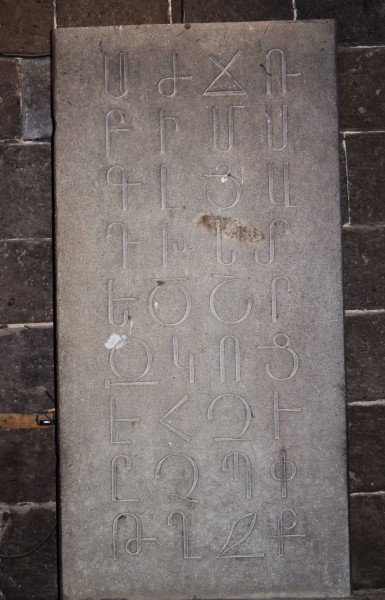
Monument to Armenian Alphabet at Oshakan
Mashtots' new alphabet mixed 21 Greek letters with 15 new phonemes. The Historical Dictionary of Armenia gives the following technical description of the complexity of the language:
Classical Armenian was a highly inflected language, with an elaborate system of declensions that retained all seven Indo-European noun cases: nominative, accusative, genitive, dative, locative, ablative, and instrumental.In this and other respects, the grammar of classical Armenian bears similarities with that of Classical Greek.(393)
To help people get to grips with the new system Mashtots ordered the letters of the alphabet, when possible, according to the Greek alphabet and put them into harmonious clusters of three. The linguist then set about testing the system on friends and pupils to see which symbols proved more troublesome in mastering. His efforts were clearly worthwhile given the speed with which the new alphabet was picked up across Armenia. Not only helping to increase literacy and usher in a golden period of Armenian literature, it was another important factor in unifying the Armenian people, cementing their identity and sense of nationhood in what was still a young state.
MASHTOTS & THE BISHOP SAHAK ASSUMED PERSONAL RESPONSIBILITY FOR THE REALLY BIG PROJECT: TRANSLATING THE BIBLE.
TRANSLATING THE BIBLE
Mashtots' work was not finished there, though. Now he had to put his creation to the purpose for which it was really invented: to spread the Christian message. Realising that he could not do this alone, the scholar set about assembling a trained team of linguists who were sent off to various cities to learn Greek or Syriac and who were then given the task of translating canons of the early church councils, liturgies, patristic texts and any other sources of value. Mashtots and the bishop Sahak assumed personal responsibility for the really big project: translating the Bible. Getting themselves an official copy from Constantinople, they cross-referenced it with other versions in Greek and Syriac to produce their definitive version in Armenian. The opening line of the Armenian Bible chosen by Mashtots was from the Proverbs of Solomon : “That men may know wisdom and instruction”.
LATER LIFE & LEGACY
Mashtots did not limit himself to translation work but also produced brand new literature in his brand new script. The scholar composed many hymns and homilies, amongst other works. In the first biography of Mashtots (and the first Armenian biography to be written), titled The Life of Mashtots ( Vark Mashtotsi ) and written by his pupil Koriun, the scholar is credited with inventing the Georgian and Albanian alphabets.
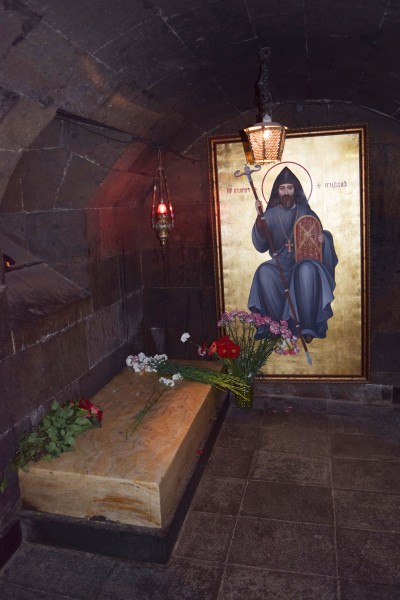
Mesrop Mashtots' Tomb
Mesrop Mashtots died in the Armenian capital of Vagharshapat on 17 February 439 (or 440 CE). He was buried in Oshakan which became a site of pilgrimage thereafter, especially following his raised status as a saint of the Armenian Church. Mesrop Mashtots continues to be revered today, too, by modern Armenians as here explained by the political historian R. Panossian:
The celebration of the alphabet and the literary work of the fifth century is sanctioned by the Armenian church as an official holiday (in October) called Surb Tarkmanchats (Holy Translators). It is noted both by the church and the laity in Armenia and in the diaspora as a celebration of Armenian literature and books. (46)
Saint Mashtots' work continues to live on today as, while the lower case of modern Armenian is based on the medieval script, the upper case of the alphabet he invented 16 centuries ago is still in use today.
This article was made possible with generous support from the National Association for Armenian Studies and Researchand the Knights of Vartan Fund for Armenian Studies.
LICENSE
Article based on information obtained from these sources:with permission from the Website Ancient History Encyclopedia
Content is available under License Creative Commons: Attribution-NonCommercial-ShareAlike 3.0 Unported. CC-BY-NC-SA License
